DISCLAIMER: I bought the actual unit I'm reviewing. I am not personally affiliated with the company in any way, nor do I receive any monetary rewards for a positive evaluation.
Photos from Jomo
PRESENTATION
Jomo Audio is a Singaporean company founded in 2015 and which, although relatively recent, has gained international recognition quite quickly. It offers a range of intras of about ten models and is best known in the world for its former flagship, the Flamenco.

TRINITY, Jomo Audio's new Flagship, was officially launched on 17/11/18.
It is the first intra triple hybrid in the world to have been commercialized. We find inside the shells which are very small :
- 1 8mm DD for basses - 20Hz to 1000Hz
- 4 BA for mediums - 1000Hz to 8000Hz
- 2 electrostatic drivers for high frequencies - 8000Hz to infinity
The internal wiring is made of silver plated copper litz, as is the stock cable.
There are two versions of TRINITY:
- Brass: purple shell with brass nozzle
- SS : grey with stainless steel nozzle
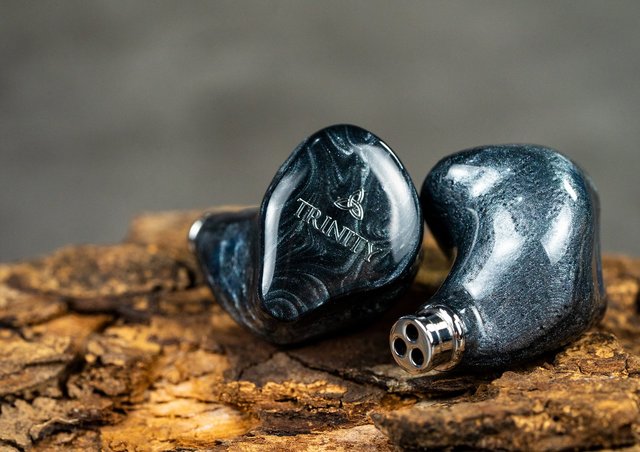
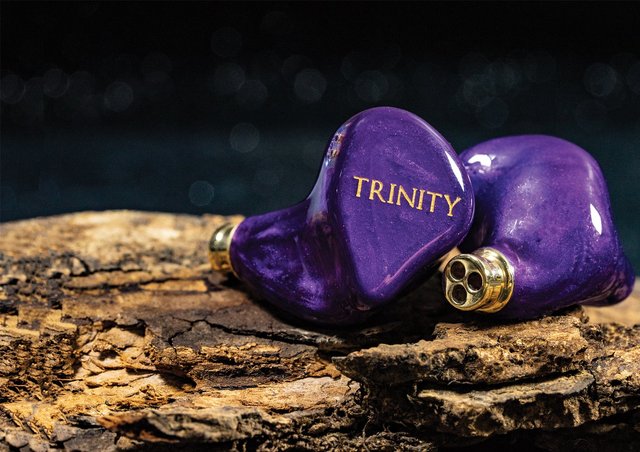
According to Joseph Mou, the boss of Jomo Audio, the tuning is exactly the same but the material used for the nozzle has an important influence on the restitution.
Here are the curves of the two versions measured by Crinacle (without compensation) :
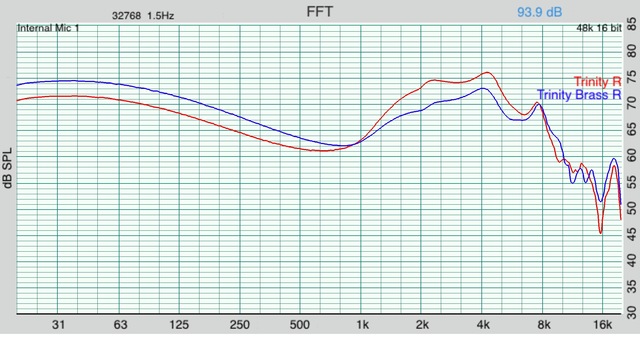
At the sight of these curves, and the first returns on Head-Fi, I decided to go for the TRINITY SS.
To date, TRINITY is only available in Universal (IEM), but Jomo Audio team is actively working on the Custom (CIEM) version.
You can also choose from the finishes offered by Jomo on their website here : Finitions
PACKAGING
Premium Italian Buttero Veg tan leather carrying case.
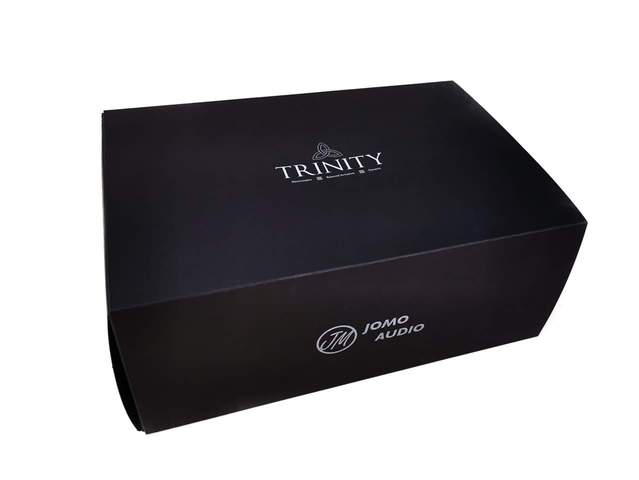
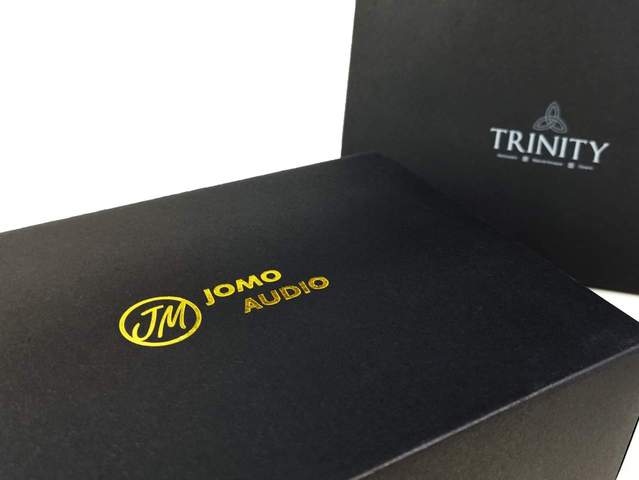
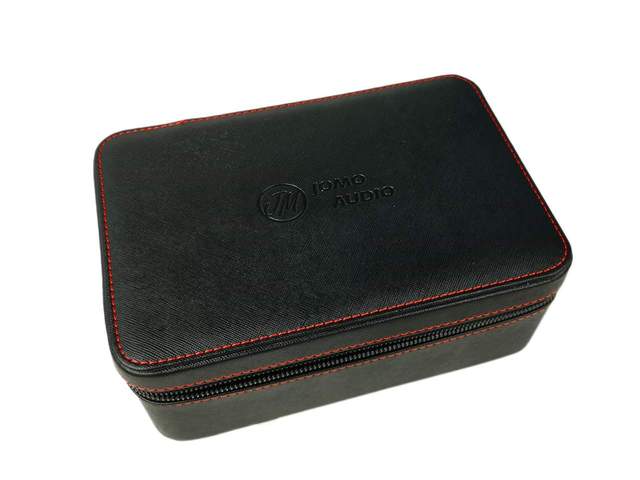
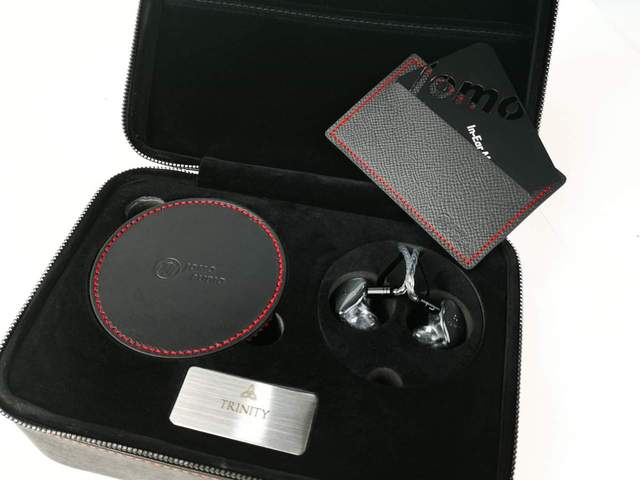
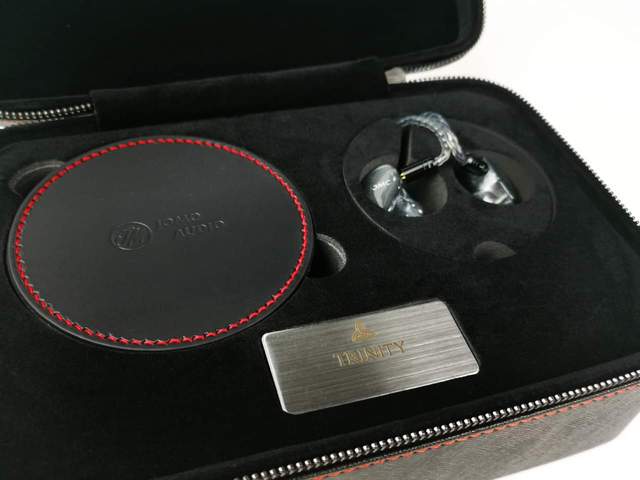
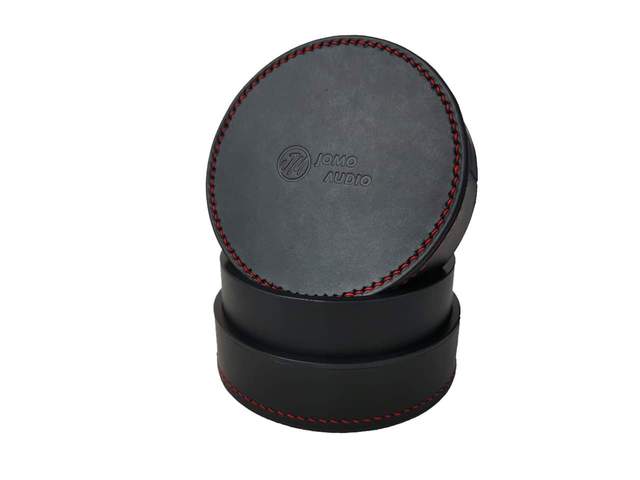
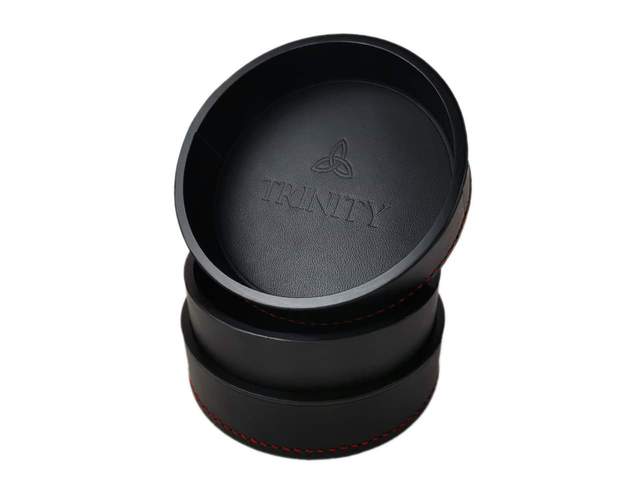

Inside the packaging there is also an aircraft adapter, a 3.5-6.35 adapter, a brush with cleaning tip and the characteristic set of tips from Jomo ; double flanges and Tornado in 3 sizes.
ERGONOMY
We have here a very ergonomic shell with a relatively small size that allows me, despite my small ears, to find the TRINITY very comfortable to wear. No discomfort is to be deplored even during extended sessions, the shell being delicately housed like a custom in the conch.
The nozzle, same size as on Flamenco, is a little wide for me. After a lot of tip rolling, I get the perfect fit with the Jomo double flange. The diameter of the nozzle is not modified and the pressure in the duct is the lowest. Spiral Dot are also quite good but apply a higher pressure.
It seems wise to me on TRINITYs to respect the nozzle exit diameter. The reduction of this one, as for Flamenco, leads to a significant decrease of the scene, especially in depth, and an increase of the bass.
TEST PROTOCOL, PLAYLIST AND LEXICON
The listening was done on a Sony WM1Z K mod premium (mod made by Music Sanctuary).
The cables that were used were the stock cable, an OAO Gold Twelve and a Brimar Supreme Reference.
When I received the TRINITY on 04/01, I spent 3 weeks listening to only these and quickly fixed myself on the OAO which is the cable that I think draws the quintessence.
I then took over Zeus XIV and could appreciate the differences between the two models by alternating the sheets. I could also compare them to the Flamenco loaned by a friend.
Since receiving the TRINITYs, I have been able to review a good part of my discotheque but I still have a relatively limited playlist that I know by heart to make my critical listening:
Angus & Julia Stone - Take you Away
Cannonball Aderley - Somethin' Else
Daft Punk - Giorgio by Moroder
Das EFX - Knockin' Niggaz Off
Du Bailly - La Folia: Yo soy la Locura
James Blake - Limit to your Love
Joan Diener - Aldonza (The Man of La Mancha)
Larry Carlton - Sunrise
Melody Gardot - Who will comfort Me
Patricia Barber - The Beat goes on
RATM - Killing in the Name
Rone - Flesh (remix by Sasha) on InFiné Exlusive compilation
Sixto Rodriguez - Sugar Man
Tool - Vicarious
A small glossary:
Soundstage : defines the three parameters that musical expression can take: width, height and depth.
Airing : defines the feeling of space between the layers, feeling of air around the musicians and singers.
Detouring / Resolution : defines the ability to define the outlines of a voice, an instrument or a group of musical instruments.
Definition : defines the ability to perceive as much information as possible
Dynamics and Transients : defines the restitution of macro and micro intensity differences, the quality of attacks and end notes.
Frequency response : defines the presence and quality of the different registers, Bass, Medium and Treble.
Respect for tones : defines the signature or sound colour specific to a musical instrument or voice.
YOU ASKED ABOUT THE SOUND ?
I remind you that the listening is done with the TRINITY SS.
Sounstage / Airing :
On this point, they are very sensitive to the recording, which they reproduce in a very beautiful way. You can find yourself on stage in front of the vocal lead, wrapped up in music, then on another track, in the middle of the audience, sometimes even at the balcony.
And this inevitably influences the perception that one can have of the sound scene. On the pieces that allow it, this one is wide + but above all exceptionally high and deep. The music breathes, the stage comes alive around us, we close our eyes and we are there.
Detouring / Resolution :
With the TRINITY we are in the top of the league on these 2 points.
The resolution of the TRINITY is incredible. The different instruments stand out clearly but at the same time offer a homogeneous and highly coherent set. The level of analysis of the recordings is excellent and allows a perfect readability of the message contained on the track being played. And Jomo has done a real goldsmith's work so that all this does not come to mind and ruin the pleasure of listening by attracting attention.
Dynamics and Transients :
TRINITY macro dynamic is rather in the high range. The liveliness of the bass drum impacts, the sharpness and suppleness of the horns, and the cymbal blows are transcribed in a very authentic way. The ADSR envelope seems to correspond to reality. It gives TRINITY a natural sound that is far above average. And in addition, there is no difference in treatment depending on the driver used, which is a tour de force.
The micro dynamic is not to be outdone either. Despite extraordinary detouring / definition, the groove released by the TRINITY is very good. And the legato is there when the music demands it.
Frequency response :
You could see the curves in the presentation, here is my feeling.
The first thing that strikes you about TRINITY is the impact of bass. They are visceral, deep and tense. The sub-bass is well present, the bass is balanced without any particular emphasis, which does not generate any boomy or cottony effect. They never overdo it and do not hide the medium. On "Limit to your love" for example, it's orgasmic.
What strikes you next is the softness of the high notes. No trace of harshness or sibilance. But under this smoothed aspect, there is in fact a high-pitched treble that runs very high and of a confounding naturalness. Electrostatic drivers bring air, space, reality. What a pleasure to be able to turn up the sound without being uncomfortable.
So what about mediums in all this ? Well, some may find them withdrawn according to their tastes, but they are well present. Versatile seems to me to be the right word. They allow the slightest inflections to pass through the voices and effortlessly translate the smallest changes in feelings.
In the end, the frequency response could be qualified as light V.
Timber :
Timbers, resulting from the last 2 points, seem right to me, and particularly at the 2 ends. The instruments sound real. We can always regret a very slight lack of body on the mediums but this is the price to pay to keep a high level of technicality and an airy presentation.
COMPARISONS
Zeus XIV :
Compared to the Zeus, the TRINITYs are more musical. They are less in apparent technical performance even if they are even more detailed with superior layering. The scene is less wide but deeper and higher, airier. More bass, less emphasized midrange as well as treble, the TRINITY is finally more balanced. Direct comparison is especially difficult for Zeus in terms of tones that appear to be almost fake.
Flamenco :
An undeniable family trait : technics at the service of music.
Flamenco is flamboyant, lively and brilliant, sometimes too much. Very full in terms of mediums, a dense restitution. The scene is coherent but not exceptional in width, height and depth.
TRINITY is more airy, more matt. The trebles spin without aggressiveness and the basses are more impactful. Mediums are more neutral. The scene is better in every respect. Resolution and layering are higher. In the end, TRINITY is slightly more laidback and I find it more natural.
CONCLUSION
Jomo's work on the TRINITY is a real tour de force. The three different technologies that are used are perfectly mastered and the consistency of the result is quite exceptional.
They offer a refined and elegant reproduction despite their abyssal basses, which is relatively uncommon. The high frequencies are a major factor in this detailed, natural and airy rendering. The laidback side allows long listening sessions without any problem.
The TRINITYs are to date the best IEM I've heard.
My topic on Tellement Nomade here : http://www.tellementnomade.org/forum/viewtopic.php?p=671123#p671123
Photos from Jomo
PRESENTATION
Jomo Audio is a Singaporean company founded in 2015 and which, although relatively recent, has gained international recognition quite quickly. It offers a range of intras of about ten models and is best known in the world for its former flagship, the Flamenco.

TRINITY, Jomo Audio's new Flagship, was officially launched on 17/11/18.
It is the first intra triple hybrid in the world to have been commercialized. We find inside the shells which are very small :
- 1 8mm DD for basses - 20Hz to 1000Hz
- 4 BA for mediums - 1000Hz to 8000Hz
- 2 electrostatic drivers for high frequencies - 8000Hz to infinity
The internal wiring is made of silver plated copper litz, as is the stock cable.
There are two versions of TRINITY:
- Brass: purple shell with brass nozzle
- SS : grey with stainless steel nozzle


According to Joseph Mou, the boss of Jomo Audio, the tuning is exactly the same but the material used for the nozzle has an important influence on the restitution.
Here are the curves of the two versions measured by Crinacle (without compensation) :

At the sight of these curves, and the first returns on Head-Fi, I decided to go for the TRINITY SS.
To date, TRINITY is only available in Universal (IEM), but Jomo Audio team is actively working on the Custom (CIEM) version.
You can also choose from the finishes offered by Jomo on their website here : Finitions
PACKAGING
Premium Italian Buttero Veg tan leather carrying case.








Inside the packaging there is also an aircraft adapter, a 3.5-6.35 adapter, a brush with cleaning tip and the characteristic set of tips from Jomo ; double flanges and Tornado in 3 sizes.
ERGONOMY
We have here a very ergonomic shell with a relatively small size that allows me, despite my small ears, to find the TRINITY very comfortable to wear. No discomfort is to be deplored even during extended sessions, the shell being delicately housed like a custom in the conch.
The nozzle, same size as on Flamenco, is a little wide for me. After a lot of tip rolling, I get the perfect fit with the Jomo double flange. The diameter of the nozzle is not modified and the pressure in the duct is the lowest. Spiral Dot are also quite good but apply a higher pressure.
It seems wise to me on TRINITYs to respect the nozzle exit diameter. The reduction of this one, as for Flamenco, leads to a significant decrease of the scene, especially in depth, and an increase of the bass.
TEST PROTOCOL, PLAYLIST AND LEXICON
The listening was done on a Sony WM1Z K mod premium (mod made by Music Sanctuary).
The cables that were used were the stock cable, an OAO Gold Twelve and a Brimar Supreme Reference.
When I received the TRINITY on 04/01, I spent 3 weeks listening to only these and quickly fixed myself on the OAO which is the cable that I think draws the quintessence.
I then took over Zeus XIV and could appreciate the differences between the two models by alternating the sheets. I could also compare them to the Flamenco loaned by a friend.
Since receiving the TRINITYs, I have been able to review a good part of my discotheque but I still have a relatively limited playlist that I know by heart to make my critical listening:
Angus & Julia Stone - Take you Away
Cannonball Aderley - Somethin' Else
Daft Punk - Giorgio by Moroder
Das EFX - Knockin' Niggaz Off
Du Bailly - La Folia: Yo soy la Locura
James Blake - Limit to your Love
Joan Diener - Aldonza (The Man of La Mancha)
Larry Carlton - Sunrise
Melody Gardot - Who will comfort Me
Patricia Barber - The Beat goes on
RATM - Killing in the Name
Rone - Flesh (remix by Sasha) on InFiné Exlusive compilation
Sixto Rodriguez - Sugar Man
Tool - Vicarious
A small glossary:
Soundstage : defines the three parameters that musical expression can take: width, height and depth.
Airing : defines the feeling of space between the layers, feeling of air around the musicians and singers.
Detouring / Resolution : defines the ability to define the outlines of a voice, an instrument or a group of musical instruments.
Definition : defines the ability to perceive as much information as possible
Dynamics and Transients : defines the restitution of macro and micro intensity differences, the quality of attacks and end notes.
Frequency response : defines the presence and quality of the different registers, Bass, Medium and Treble.
Respect for tones : defines the signature or sound colour specific to a musical instrument or voice.
YOU ASKED ABOUT THE SOUND ?
I remind you that the listening is done with the TRINITY SS.
Sounstage / Airing :
On this point, they are very sensitive to the recording, which they reproduce in a very beautiful way. You can find yourself on stage in front of the vocal lead, wrapped up in music, then on another track, in the middle of the audience, sometimes even at the balcony.
And this inevitably influences the perception that one can have of the sound scene. On the pieces that allow it, this one is wide + but above all exceptionally high and deep. The music breathes, the stage comes alive around us, we close our eyes and we are there.
Detouring / Resolution :
With the TRINITY we are in the top of the league on these 2 points.
The resolution of the TRINITY is incredible. The different instruments stand out clearly but at the same time offer a homogeneous and highly coherent set. The level of analysis of the recordings is excellent and allows a perfect readability of the message contained on the track being played. And Jomo has done a real goldsmith's work so that all this does not come to mind and ruin the pleasure of listening by attracting attention.
Dynamics and Transients :
TRINITY macro dynamic is rather in the high range. The liveliness of the bass drum impacts, the sharpness and suppleness of the horns, and the cymbal blows are transcribed in a very authentic way. The ADSR envelope seems to correspond to reality. It gives TRINITY a natural sound that is far above average. And in addition, there is no difference in treatment depending on the driver used, which is a tour de force.
The micro dynamic is not to be outdone either. Despite extraordinary detouring / definition, the groove released by the TRINITY is very good. And the legato is there when the music demands it.
Frequency response :
You could see the curves in the presentation, here is my feeling.
The first thing that strikes you about TRINITY is the impact of bass. They are visceral, deep and tense. The sub-bass is well present, the bass is balanced without any particular emphasis, which does not generate any boomy or cottony effect. They never overdo it and do not hide the medium. On "Limit to your love" for example, it's orgasmic.
What strikes you next is the softness of the high notes. No trace of harshness or sibilance. But under this smoothed aspect, there is in fact a high-pitched treble that runs very high and of a confounding naturalness. Electrostatic drivers bring air, space, reality. What a pleasure to be able to turn up the sound without being uncomfortable.
So what about mediums in all this ? Well, some may find them withdrawn according to their tastes, but they are well present. Versatile seems to me to be the right word. They allow the slightest inflections to pass through the voices and effortlessly translate the smallest changes in feelings.
In the end, the frequency response could be qualified as light V.
Timber :
Timbers, resulting from the last 2 points, seem right to me, and particularly at the 2 ends. The instruments sound real. We can always regret a very slight lack of body on the mediums but this is the price to pay to keep a high level of technicality and an airy presentation.
COMPARISONS
Zeus XIV :
Compared to the Zeus, the TRINITYs are more musical. They are less in apparent technical performance even if they are even more detailed with superior layering. The scene is less wide but deeper and higher, airier. More bass, less emphasized midrange as well as treble, the TRINITY is finally more balanced. Direct comparison is especially difficult for Zeus in terms of tones that appear to be almost fake.
Flamenco :
An undeniable family trait : technics at the service of music.
Flamenco is flamboyant, lively and brilliant, sometimes too much. Very full in terms of mediums, a dense restitution. The scene is coherent but not exceptional in width, height and depth.
TRINITY is more airy, more matt. The trebles spin without aggressiveness and the basses are more impactful. Mediums are more neutral. The scene is better in every respect. Resolution and layering are higher. In the end, TRINITY is slightly more laidback and I find it more natural.
CONCLUSION
Jomo's work on the TRINITY is a real tour de force. The three different technologies that are used are perfectly mastered and the consistency of the result is quite exceptional.
They offer a refined and elegant reproduction despite their abyssal basses, which is relatively uncommon. The high frequencies are a major factor in this detailed, natural and airy rendering. The laidback side allows long listening sessions without any problem.
The TRINITYs are to date the best IEM I've heard.
My topic on Tellement Nomade here : http://www.tellementnomade.org/forum/viewtopic.php?p=671123#p671123
















